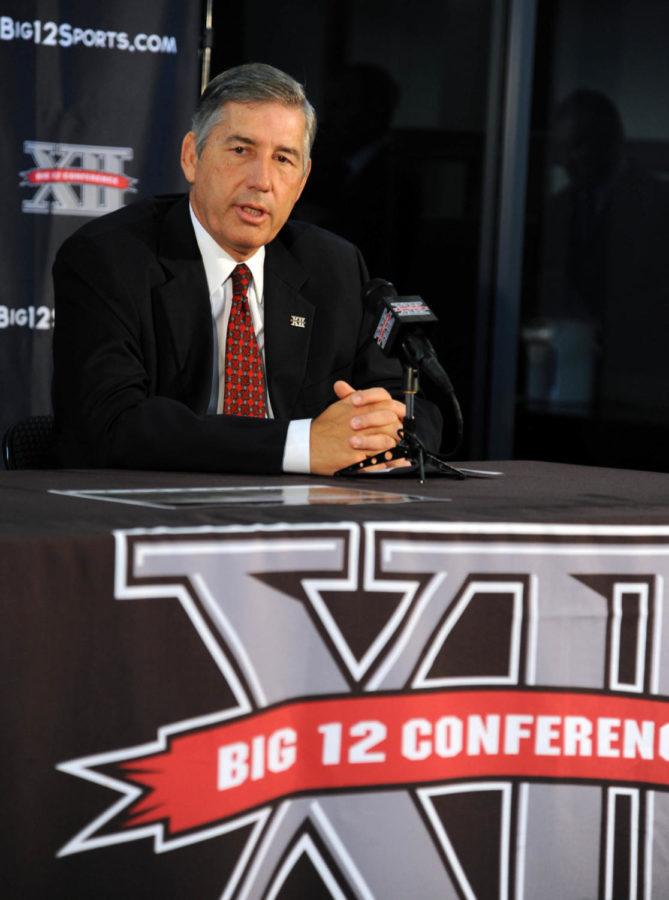Big 12 Conference hopes to prove stability with new comissioner
May 16, 2012
In office as ISU president for only four months, Steven Leath has been forced to learn fast as the Big 12 Conference quickly changes.
When Leath took office Jan. 16, the Big 12 was just months removed from the subtraction of Dan Beebe as commissioner and in the midst of watching two of its institutions — Missouri and Texas A&M — depart for the Southeastern Conference.
The perceived instability of the conference forced Leath and ISU Athletic Director Jamie Pollard to form a quick working relationship.
“It was a very fast pace, so the first thing is Jamie and I sat down and talked about what issues were coming up,” Leath said. “We would talk fairly regularly to make sure we were both approaching the issues with the same perspective.”
On May 3, the Big 12 took a leap toward renewed stability, announcing the hiring of Stanford Athletic Director Bob Bowlsby as its new commissioner. He will replace Chuck Neinas, who stepped in as an interim commissioner with the departure of Beebe.
Bowlsby, who was heavily involved in both expansion and television contracts for the Pacific-12, admitted he was initially weary about the proposition but was comforted after talking with those in the conference.
“I was very satisfied and probably it would be correct to say encouraged and impressed with the stability and the mutual commitment [of the institutions],” Bowlsby said at his introductory news conference. “At this point I have no reservations about that.”
Bowlsby, a native of Waterloo, Iowa, acted as the athletic director at Northern Iowa for eight years before taking over as athletic director at Iowa from 1991 through 2005. His experience made him the No. 1 option for the leaders of the Big 12, according to Leath.
“He has a lot of experience in college athletics, and he functioned not only as an athletic director, but he functioned in three different conferences,” Leath said. “He had a very good perspective to really know what was going on in college athletics.”
Pollard said the familiarity of Bowlsby from fellow Big 12 athletic directors helped make him a strong candidate. Pollard himself, when he was the deputy athletic director at the University of Wisconsin, formed a strong working relationship with Bowlsby.
“Most everybody in [the Big 12] room had worked with him before, and he had proven himself as having great credibility with our administrators plus the coaching staffs,” Pollard said. “We had watched him on a national level have great political savvy and be able to know what buttons to push and when to push them.”
When Bowlsby takes over as commissioner on June 15, he will take on two more major issues facing the Big 12: a television contract and expansion.
Pollard said Bowlsby’s work with the Big Ten Network as well as the Pac-12 Network, which will debut in August, will be beneficial. He added that a new Big 12 television contract will probably “happen sooner than later.”
As for expansion, the Big 12 will sit at 10 teams when football rolls around next fall. Bowlsby said expansion will be looked at, but he does not have his mind set on any particular number of institutions.
“There’s nothing magic about 11, 12 or 10,” Bowlsby said. “To the extent that we can do things that advance our agenda, we ought to at least consider that. … We are pretty excited about the 10 institutions that we have right now.”
With the addition of both West Virginia and Texas Christian to the Big 12 for the 2012-13 athletic year, the conference took a step toward stability. The addition of Bowlsby as Big 12 commissioner is just the latest in a string of events that have renewed balance to the Big 12 conference.
After learning quickly on the job, Leath has begun to settle in, and his conversations with Pollard will continue as the Big 12 continues to pursue new opportunities and face upcoming issues.
Until those next issues arise, the Big 12 will look to prove to the general public that the conference is stable — even if its leaders have felt comfortable all along.
“Those of us in the room knew it was more stable than what people perceived it on the outside,” Pollard said. “In the long run we’ll just have to show it in order to get the outside to believe it.”







